
Hungary
The town of Keszthely stands at the western tip of Lake Balaton. It is a mixture of old and new, commercial and resort. It has some of the most fashionable hotels on the lake and pulls in visitors from miles around to see the magnificent stately home, the Festetics-kastély, with its church-like baroque tower at the highest part of the town. It used to overlook the lake, now the modern town lies at its feet. From the castle the main shopping street stretches south towards the remaining medieval church of the town.
Plébániatemplom
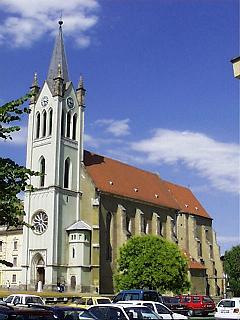 |
The plébániatemplom (parish church) stands in the main square. The site is C12 but it was rebuilt in 1386. The former franciscan monastery buildings adjoin to the north. All was part of the defences of the town in the C16 which resisted the many attacks of the Turks. The church was baroquised in c1747 but this was been removed at the end of the C19 when the tower was added in a contrasting white stone. This tower has a rose west window, said to be original.
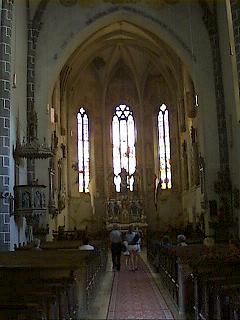
The interior is very dark and consists of an aisleless nave, and slightly lower apsidal choir. During a restoration in 1974 a large number of C15 wall-paintings were uncovered in the choir.
As the town continued to grow a number of new churches were built in an eclectic style. In the Hanczók utca the Calvinist church (Református templom) dates from 1930 by the architect Szeghalmy Bálint looks like a Romanian country church whilst the same architect's Lutheran church (Evangélikus templom) built in the same year recalls the baroque town churches of Germany. The St Nicholas (Szent Miklós) cemetery chapel was originally of 1713, altered 1775 and completely rebuilt in a insipid Romanesque in 1909. Further out on the main road into the town from the northern shore of Lake Balaton you can hadly miss the
Karmelita Bazilika (Kis Szent Teréz)
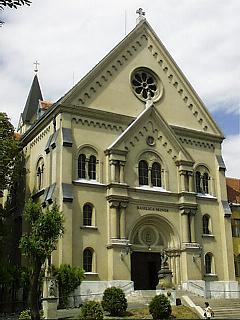
The Carmelite Basilica dedicated to Little Saint Theresa is a large Italian Romanesque building with a NE campanile. It was begun in 1927 to the designs of Bruno Bruckwieser of Vienna and the church was completed in 1930. The White Friars were ejected in 1945 and the church became a parish church. In 1989 the Friars returned and the church was raised to the status of Basilica Minor in the same year. The damaged campanile has been reconstructed , completed in c1999.
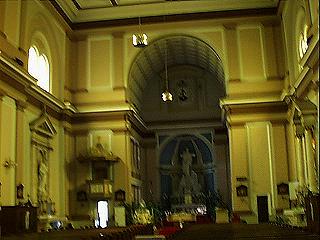
I must say that the interior is somewhat disappointing. There are no aisles, just a west gallery and an eastern sanctuary break up the rectangular shape. It has a flat panelled ceiling and is more classical inside then the playful Romanesque design of the exterior. The embellishment of the church proceeded through the 1930s, the High Altar in 1932, and the church was finally consecrated in 1938.
The small town of Nagyvászony lies north of Lake Balaton in the folds of the Bakony Hills. It was once a very important town, but today is little more than a sizeable village. The main street links two small baroque style churches (both locked, one the Reformed church of the late-C18 with tower of 1826 and the other catholic of 1777), and has a couple of shops and is a turn around for several buses (as we sat quietly munching lunch in the sun at least four buses did this - typical!). Having parked up we began to explore, spotting none of the other buildings mentioned in the guidebook. At the far end of the town is a large cemetery - go through this diagonally towards the woods and find a small path leading through the trees to the Paulite Church
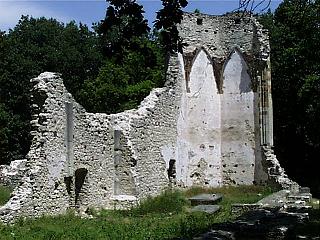
These ruined walls are all that remains of the church founded by the legendary Pál Kinizsi at the end of the C15. He fought off many attacks by the Turks, and recieved the castle here as a present from the King. In fact if I am honest, the churches pale into insignificance alongside this magnificent ruined castle.
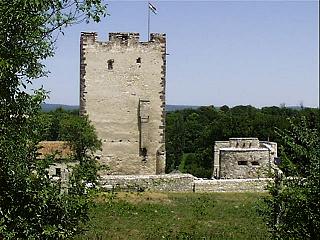
This building still retains its enormous keep and serves as a small local museum. The views from the top over the Bakony Hills is superb, and looking northwards you can glimpse the medieval parish church of Nagyvászony in the trees (also locked, surrounded by scaffolding and polythene and obviously undergoing restoration. Dedicated to St Stephen, it was built c1480 and baroquised in c1740).
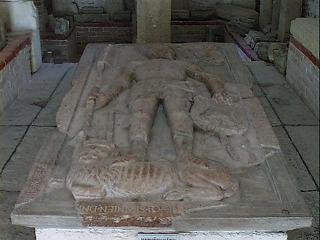
In the rebuilt castle chapel are a number of survivals of the former church and its contents, including this massive gravestone with effigy. In fact on this extremely hot day the pleasures of staying in the keep were only outdone by hiding in the chapel crypt!
Back to the Hungary Pages Intro and Index